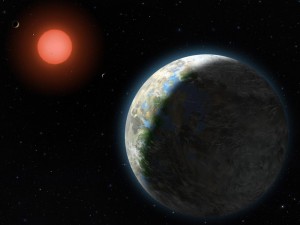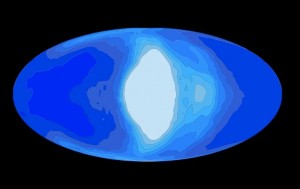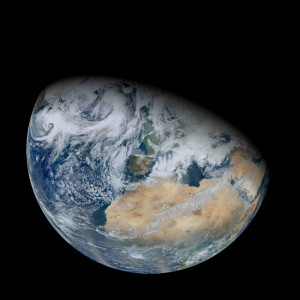
A planet with clouds and surface water orbits a red dwarf star in this artist’s conception of the Gliese 581 star system. (Illustration: Lynette Cook)
A new study finds there could be about 60 billion Earth-sized habitable planets orbiting red dwarfs – the most common stars in our universe – in the Milky Way galaxy.
That’s more than twice as many potentially habitable planets than was previously thought.
The new report from two Chicago area universities finds that clouds surrounding these planets may be hiding them from detection.
The researchers drew upon current data from NASA’s Kepler Mission, which searched for Earth-like planets orbiting other stars up until this past May. The new study from Northwestern University and the University of Chicago suggests there is approximately one Earth-size planet in the habitable zone of each red dwarf.
“Most of the planets in the Milky Way orbit red dwarfs,” said Nicolas Cowan, a postdoctoral fellow at Northwestern University. “A thermostat that makes such planets more clement means we don’t have to look as far to find a habitable planet.”
The findings contradict other recent studies, including one from the Harvard-Smithsonian Center for Astrophysics, which found our galaxy has about 4.5 billion Earth-sized planets. Another study from the California Institute of Technology (Caltech) estimated there are about 30 billion of these planets in our galaxy.
“Those numbers are confusing, partially because they are still being sorted out,” Cowan said in an email to Science World.
All three studies were based on virtually the same data from Kepler.
While the Harvard-Smithsonian and Caltech studies each used 1D modeling to reach their findings, the Chicago area based study used a 3D model.
“Our 3D calculations of the HZ [Habitable Zone] move its inner edge much closer to the star,” said Cowan. “The Kepler planetary demographics tell us how many planets orbit at what distance from their host star. We therefore know that our revision to the HZ accommodates roughly twice as many planets.”

This illustration shows simulated cloud coverage (white) on a tidally locked planet (blue) that would be orbiting a red dwarf star. (Illustration by Jun Yang)
For decades, scientists have said that a star’s habitable zone is an area where planets can orbit their star while still being able to retain liquid water at their surfaces. But the researchers say that formula doesn’t take clouds, which have a major climatic influence, into consideration.
“Clouds cause warming, and they cause cooling on Earth,” said Dorian Abbot, an assistant professor in geophysical sciences the University of Chicago and member of the research team. “They reflect sunlight to cool things off, and they absorb infrared radiation from the surface to make a greenhouse effect. That’s part of what keeps the planet warm enough to sustain life.”
According to the team’s research, in order for a planet to be maintain liquid water it would need to complete an orbit around its star about once a year, just as Earth orbits the sun.
But, “if you’re orbiting around a low mass or dwarf star, you have to orbit about once a month, once every two months to receive the same amount of sunlight that we receive from the sun,” Cowan said.
Since these planets would maintain such tight orbits, they would sooner or later become “tidally locked with their sun,” with the same side of the planet are always facing their suns, similar to how the moon orbits around Earth. According to computations made by the Chicago area team, the sun would always be directly above the planet, “at high noon.”
If astronomers find that tidally locked planets have no substantial cloud cover, they will measure the highest temperatures of the planet when its dayside faces their telescopes. When that planet continues its orbit around its star and shows its dark side to the telescope, temperatures would reach their lowest point.
But if the exoplanet has highly reflective clouds dominating its dayside, they would block much of the infrared radiation from its surface.
“You would measure the coldest temperatures when the planet is on the opposite side, and you would measure the warmest temperatures when you are looking at the night side, because there you are actually looking at the surface rather than these high clouds,” said Jun Yang, a member of the research team from the University of Chicago.
Previous efforts to simulate an exoplanet habitable zone’s inner edge were used one-dimensional calculations and mostly ignored clouds, said the Chicago researchers. Their work instead focused on charting how temperature decreases with altitude.
For the first time, by using three-dimensional global calculations, the research team was able to find the effect of water clouds on the inner edge of the habitable zone. The team used simulations similar to those used to predict Earth’s climate.
“There’s no way you can do clouds properly in one-dimension,” Cowan said. “But in a three-dimensional model, you’re actually simulating the way air moves and the way moisture moves through the entire atmosphere of the planet.”
The research team anticipates the forthcoming James Webb Space Telescope will verify its findings. If the new telescope, which NASA hopes will launch in 2018, detects a signal from an exoplanet, “it’s almost definitely from clouds, and it’s a confirmation that you do have surface liquid water,” said Abbot.






















The main issue isn’t the number of planets there are out there that can potentially support life, but the huge distance with these planets. If you don’t know it, I suggest you take a look at The Scale of Universe http://adf.ly/RV7JK